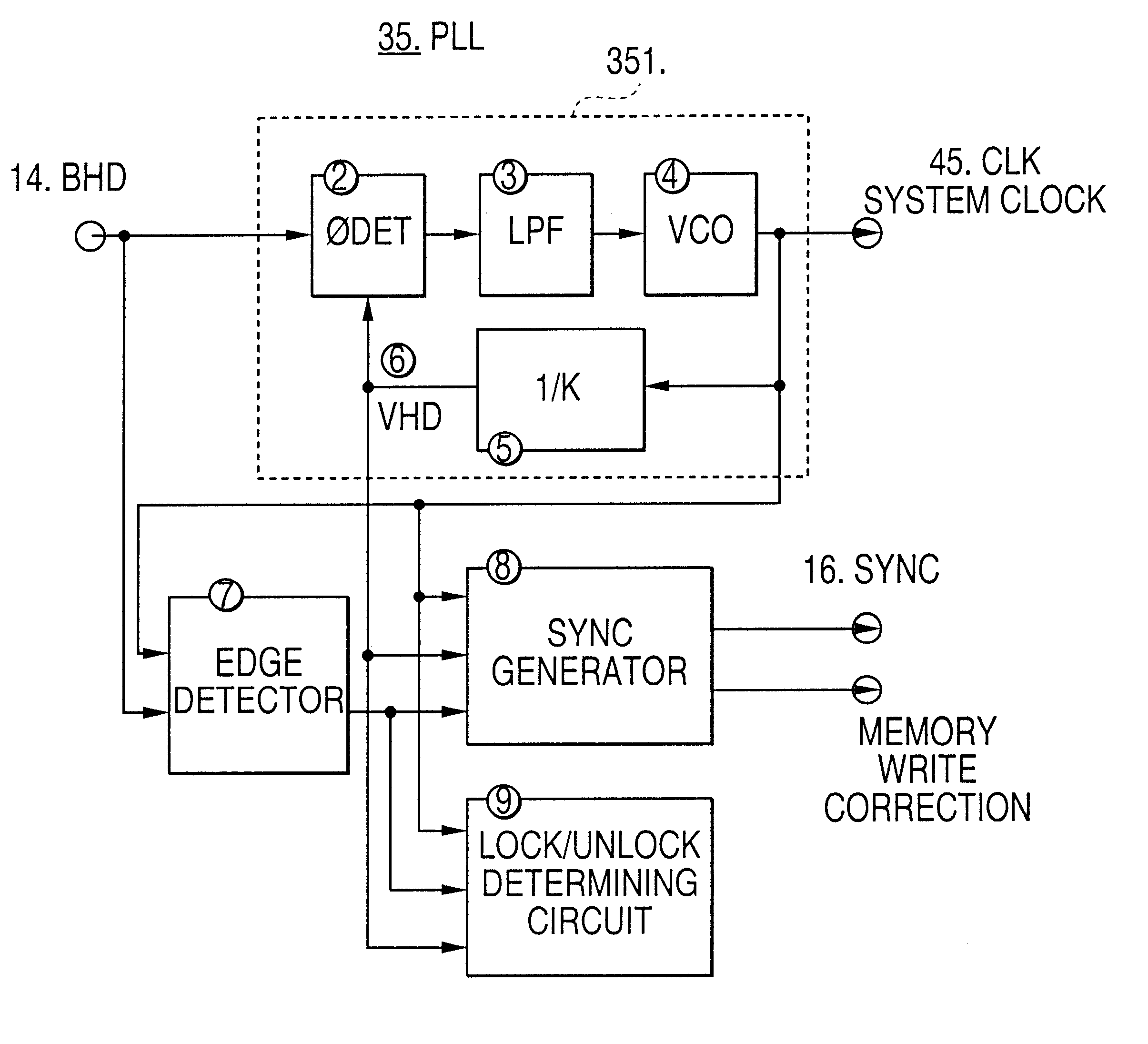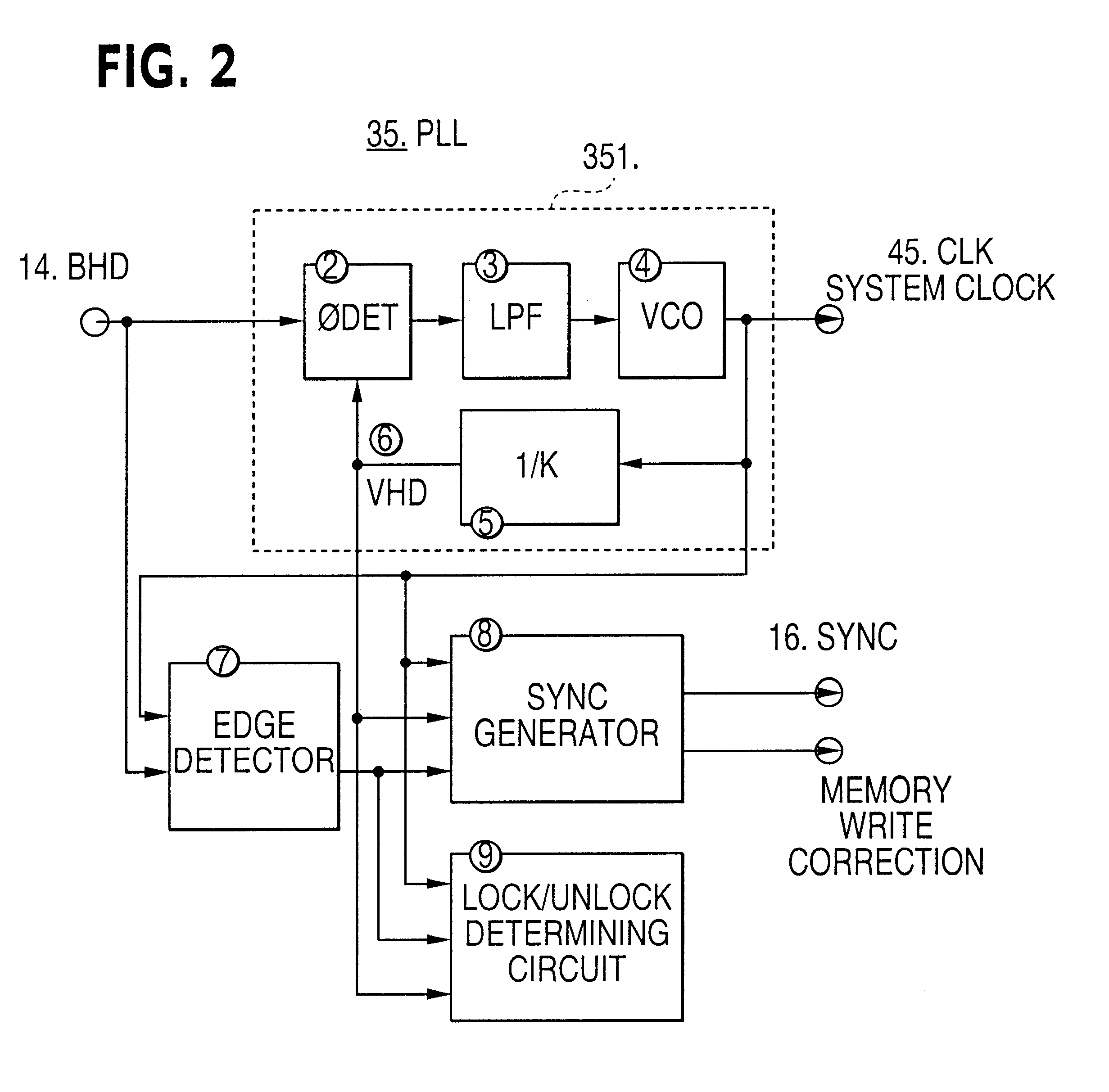PLL circuit for digital display apparatus
a digital display and circuit technology, applied in the field of pll circuits for digital display apparatuses, can solve the problems of disturbing images, significant phase difference, blackening the screen, even temporarily,
- Summary
- Abstract
- Description
- Claims
- Application Information
AI Technical Summary
Benefits of technology
Problems solved by technology
Method used
Image
Examples
first embodiment
According to this invention, as the internal sync signal (SYNC) 16, the comparison signal is used when the PLL circuit is in a locked state, and the external horizontal sync signal (EHD) 14 externally supplied is used in an unlocked state, as mentioned above. Detection of lock-off is carried out by monitoring a phase difference between the external horizontal sync signal 14 and the comparison signal.
FIG. 2 is a block diagram of the internal structure of the PLL circuit 35 in FIG. 1. FIG. 3 is a timing chart for explaining how the PLL circuit 35 switches the internal sync signal (SYNC) 16.
Input to the PLL circuit 35 in FIG. 2 is the horizontal sync signal (EHD) 14, which is separated from the composite image signal by the sync separator 34 as mentioned above. As outputs, the system clock signal (CLK) 45 and the internal sync signal (SYNC) 16 are output. "2" denotes a phase comparator which compares the phase of the horizontal sync signal EHD 14, input externally, with the phase of a ...
second embodiment
A second embodiment of this invention will now be described. In this invention, even when the external horizontal sync signal (Hsync) 14 includes a skew pulse or an extra pulse or has a pulse drop-out or the like, the lock-in state of the PLL circuit 35 can be maintained as much as possible, preventing the circuit from going into an unstable unlocked state for a long period of time. As a result, the PLL circuit 35 can generate a stable system clock signal.
FIG. 6 is a block diagram exemplifying a PLL circuit according to the second embodiment of this invention. FIG. 6 shows the PLL circuit 35 in FIG. 1 excluding the sync separator 34 in FIG. 1 and an equivalent pulse killer circuit 341 which accompanies the separator. The equivalent pulse killer circuit 341 removes an equivalent pulse to bisect a horizontal sync signal, which is constituted by a double frequency in order to cope with the interlace type CRT in a case of the normal NTSC composite image signal.
A portion 351 surrounded b...
third embodiment
this invention provides a synthesizing circuit which has both the function of the PLL circuit of the first embodiment and the function of the PLL circuit of the second embodiment. FIG. 13 is a block diagram of the internal structure of such a synthesizing circuit. Referring to FIG. 13, "351" denotes an ordinary PLL circuit portion, "352" denotes the PLL circuit according to the second embodiment and "35" denotes a PLL circuit to which the function of the PLL circuit of the first embodiment is added.
In the synthesizing circuit according to the third embodiment, the PLL circuit of the first embodiment serves to detect a phase difference between the external horizontal sync signal 14 and the comparison signal 6, and when there is a phase difference, it determines the state as an unlocked state and switches the internal sync signal 16 to the external sync signal 14. The internal sync signal 16 during the unlock-in period is kept to the external sync signal 14.
Further, the PLL circuit of...
PUM
 Login to View More
Login to View More Abstract
Description
Claims
Application Information
 Login to View More
Login to View More - R&D
- Intellectual Property
- Life Sciences
- Materials
- Tech Scout
- Unparalleled Data Quality
- Higher Quality Content
- 60% Fewer Hallucinations
Browse by: Latest US Patents, China's latest patents, Technical Efficacy Thesaurus, Application Domain, Technology Topic, Popular Technical Reports.
© 2025 PatSnap. All rights reserved.Legal|Privacy policy|Modern Slavery Act Transparency Statement|Sitemap|About US| Contact US: help@patsnap.com



